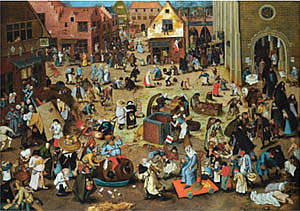Rush of Berbers

In the nineteenth century the world capital of the Carnival was Rome; until the fifteenth century was the feast that the ordinary people made on the streets of Testaccio to celebrate the end of winter, until Pope Paul II, Peter Barbo, decided it would be the feast of all people and made organizing mythological representations, parades of Bacchus and races that starting from Domitian arch on Via Lata arrived until under its loggia of his palace, that would become the Venice Palace.
Races were one of the Carnival events together with "Feast of moccoletti " (candle-end) and the parade of carriages with the "Launch of Confetti" (chalk balls that opened to the contact with masquerades people).
These carnival rides were for riderless horses and were introduced in the mid-seventeenth century instead of racing, which until then were held in eight days no holidays, except Saturdays also, preceding the beginning of Lent; these races were reserved for special categories:
- The first day ran the Jews who were forced to eat a lot to be less agile;
- On the second day running Christian children;
- On the third day running young Christians;
- On the fourth day they ran the old with more than 60 years;
- On the fifth day running running donkeys;
- At the end there was the race of the buffaloes.
By the time you held races for dwarfs, for lame and deformed at sight of whom the people was amused and did not spare them jokes, or throwing objects; in 1667 Pope Clement IX abolished the barbaric practice and since then the races were only for horses.
The rush started from People's Square and along the entire straight stretch of the Via Lata, about 1.5 km, arrived to Piazza Venezia. At Piazza del Popolo scaffolds they were mounted both to delimit the starting area, but above all to prepare the seats from which the Roman aristocracy could attend, without any danger, at the beginning of the race; the ordinary people crowded on the slopes of the Pincio to be able to see the start.
Of the race there is a detailed account of Bergsøe, a Danish poet lived for a while in Rome:
"Nine horses excited by screams were conducted at the starting line. These horses do not have the elegant look of racehorses, because their tails are tied, their manes braided fittemente and their muscles covered by monstrous metal blades fitted within spines that are designed to unnerve the most of the poor beast. In addition to these blades it is connected to a large number of detonators. A dozen grooms seeking with difficulty to retain excited horses until the cord falls and they start with the speed of lightning, even terrified by the screams of the spectators and the noises that go with them until the end of the race " ...
Sign up and read the rest of the article!
by M.L. ©ALL RIGHTS RESERVED (Ed 1.0 - 15/09/2016)






